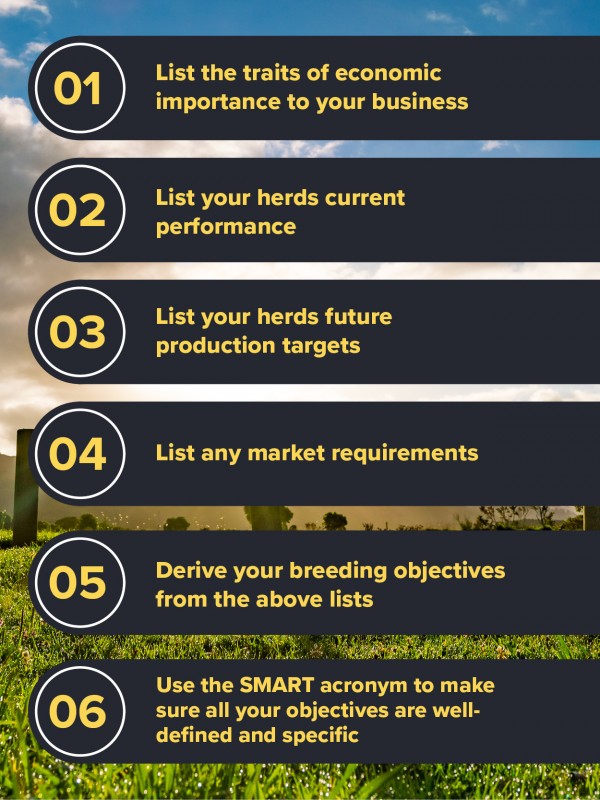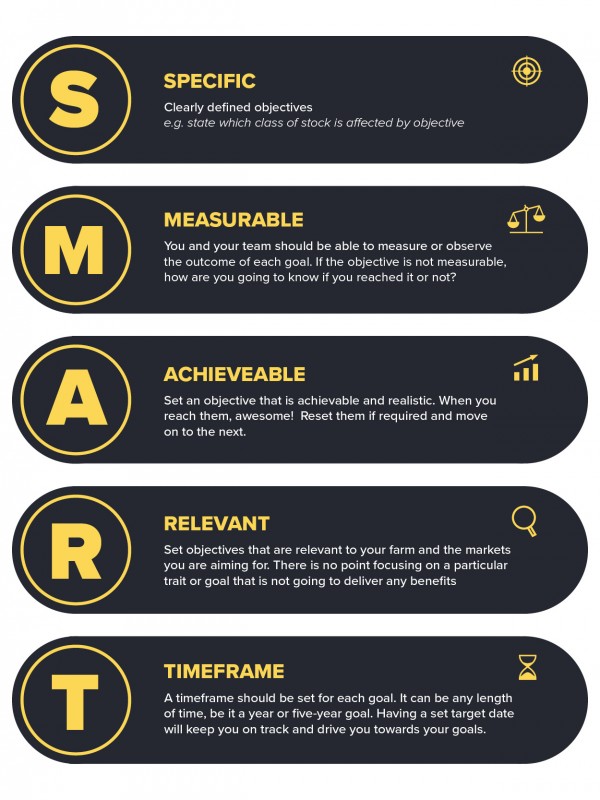If I were to ask you what your breeding objectives were, would you be able to answer straight away?
If I asked you, are your breeding objectives laid out in a SMART goal format and reviewed every year, would your answer be yes?
What about whether they are written down as a physical copy that you can clearly communicate to your bank manager, your shepherd, or your team so they too understand your objectives?
The foundation of any successful breeding program is having a well-defined breeding objective. It brings a business approach to farming, reminding you of the bigger picture, and catering for pressures caused by uncertain weather or market failures.
A breeding objective defines the overall goals of your breeding program, and the traits that are targeted for genetic improvement. It can be as simple as selecting a breed, or as in-depth as increasing weaning weight by a determined amount. Breeding objectives are often centred around maximising profit and efficiency or minimising economic risk.
Your breeding objective will be unique to your business. Whether you have a single objective or multiple, careful thought needs to go into creating them as they will shape the future of your herd and business. Think of your breeding objective as a living document. It should be a balance between something you follow strictly, while adaptable enough to cater for any drastic environmental, management, or market changes.
It is also important to note it is easier to focus on improving a select few traits, rather than attempting to improve them all at once.
There are many things to consider when setting your objective, so we have simplified the process down to six steps.

The SMART acronym stands for Specific, Measurable, Achievable, Relevant, and Timeframe. Structuring your objective in this way acts as a powerful catalyst, helping you avoid vague, unrealistic, or irrelevant goals, and instead create ones that are clear, realistic, and aligned with your breeding vision and mission. This will encourage predetermined practical decision making ahead of time, minimising decision-fatigue and concentrating efforts in making wise business choices that increase the efficiency and competitiveness of your program in the long run.

Why is creating a physical written copy of your objectives important?
If you can’t write down your breeding objective, you mostly likely can’t communicate it to your team, set clear expectations and build a common objective to strive towards together. It’s all good and well holding it inside your head, but sharing them on paper will ensure everyone understands their role, fostering a culture of responsibility, accountability, and commitment. Moreover, setting your breeding objective in a SMART format provides you with a framework to monitor performance, provide feedback, adjust as required, and stay on track.
It is important your breeding objectives are reviewed yearly, monitoring progress, re-aligning any actions and setting any additional objectives. Ask yourself, can any be ticked as completed? Has clear progress been made? Has the market changed, rendering any of the objectives irrelevant?
Key Points
- Breeding objectives are a key component of a successful breeding program. They ensure your herd and business heads in the direction you are aiming for, and fosters adaptability, resilience and stability within your program.
- Setting and reviewing your breeding objectives every year can be an easy task if you follow our six simple steps.
- Laying your breeding objective in a SMART goal format provides a framework for well-defined goals that align with your breeding mission and values
- Creating a physical copy of your breeding objective is crucial to ensuring both you and your team are all on the same page